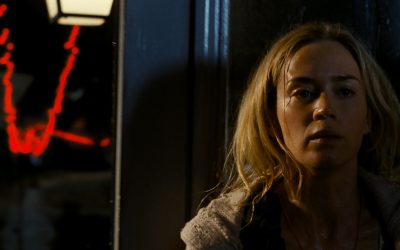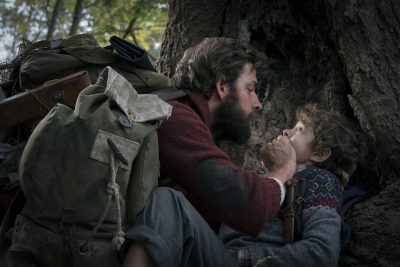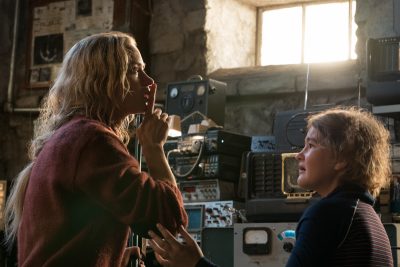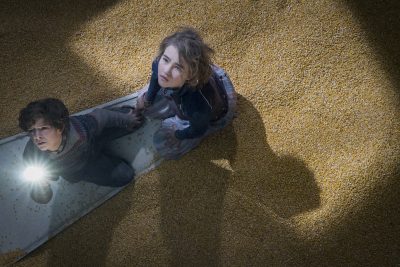
A Quiet Place – Evelyn Abbott (Emily Blunt) – Photo courtesy of Paramount Pictures.
First, let me make something perfectly clear – I can’t decide whether A Quiet Place is an alien invasion movie cleverly disguised as a horror movie, or a horror movie cleverly disguised as an alien invasion movie.
Whatever the case, it’s a clever, original, haunting frequently scary film that has, at its heart, the bonds of family.
We open on shadowy figures moving around a deserted supermarket before zeroing on a woman checking bottles of medication in the store’s pharmacy – followed by the family assembling at what used to be the front counter.
This is the Abbott family: father Lee (John Krasinski – who produced, directed and co-wrote the movie), mother Evelyn (Emily Blunt), teenaged daughter Reagan (Millicent Simmonds), preteen son Marcus (Noah Jupe) and post-toddler son Beau (Cade Woodward).

A Quiet Place – Lee Abbott (John Krasinski) and Marcus Abbott (Noah Jupe) – Photo courtesy of Paramount Pictures.
Beau is attracted to a toy space shuttle, but his father says it’s too loud – in sign language – the whole family has been unusually quiet. As they leave the store, we see the front page of a newspaper with the headline, It’s Sound!
It takes less than ten minutes before we learn why it’s so important to be quiet. Whatever has happened, there are creatures that locate their foes by sound.
Our glimpse of one of the creatures is so fleeting that we can almost make out that it’s some kind of bug.
A Quiet Place takes some pains to establish the world the Abbotts live in – they walk barefoot on some kind of sand that has been laid down as paths from the Abbotts’ underground yet cozy bunker to the supermarket; to the fields; across a bridge.

A Quiet Place – Evelyn Abbott (Emily Blunt) and Regan Abbott )Millicent Simmonds – Photo courtesy of Paramount Pictures.
By the time we’ve had our fleeting glimpse of whatever the hell that was, we already understand the importance of silence – those paths, and the fact that the Abbotts are barefoot and treading softly, have already given us clues as to the world that exists 89 days after the apocalypse.
Most of the sounds in A Quiet Place are sounds of nature – or the muted footfalls of very cautious people. The movie’s mostly silent for long stretches, frequently with a muted score that quietly ramps up tension (kudos to composer Marco Beltrami for being so precise).
Like a good Roger Corman movie from the sixties and seventies, Krasinski keeps the beasties off camera except for glimpses of legs, or parts of the body – giving us just enough to kind of imagine what it might look like, but also enough that the reveal is of a creature that doesn’t look like what we might have imagined yet fits what we’ve seen.
That creature is a beautifully designed, genuinely horrifying giant bug with telescoping ears that can pick the sound of ‘lunch’ from a distance.
By 489 days after the apocalypse, we’ve gotten three deaths – one through lack of understanding; one through rage and loss, and one through love.

A Quiet Place – Marcus Abbott (Noah Jupe) and Regan Abbott (Millicent Simmonds) – Photo courtesy of Paramount Pictures.
None of the deaths is particularly grisly – in fact, they happen so quickly and thoroughly that we don’t even see much blood. The terror comes from knowing there is a deadly creature (or creatures, as we find out well into the movie) that can take a life so quickly that there seems to be no defense.
There is, of course, but it might be discovered too late – Krasinski leaves that up to us to decide (though the last shot raises a very welcome laugh).
Small details help make A Quiet Place so good. Like the way the Abbots communicate with sign language. It’s not gratuitous – Regan is deaf (as is Simmonds), so they’ve been using it since well before the invasion; or like the way the family says a silent grace before a meal; establishing that they believe in something greater than themselves.
It takes faith and hard work to survive in the Abbotts’ world – and they have plenty of both – even if sometimes, some of them seem to falter.
A Quiet Place is an entertaining, frequently scary movie about a family just trying to get on with their lives in the worst possible circumstances.
Final Grade: A